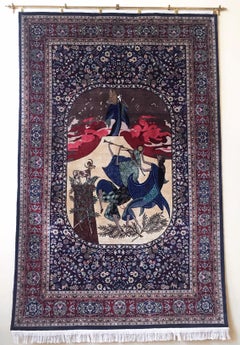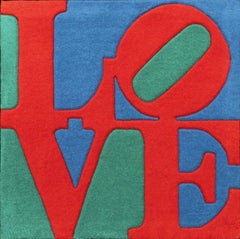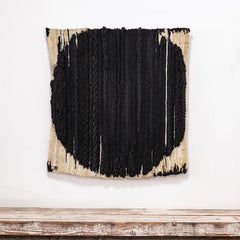RoGallery More Art
Color: Black
Moses and the Ten Commandments (Passover), Large Tapestry Rug by Shlomo Katz
By Shlomo Katz
Located in Long Island City, NY
Artist: after Shlomo Katz, Polish/Israeli (1937 - 1992)
Title: Moses and the Ten Commandments (Passover)
Year: 2000
Medium: Woolen Carpet Tapestry
Size: 84 x 54 in. (213.36 x 137.16 cm)
Category
Early 2000s Expressionist More Art
Materials
Tapestry, Wool
Related Items
Classic Love
By Robert Indiana
Located in New York, NY
Robert Indiana’s, "Classic Love" tapestry is a wool iteration of the artist's iconic “LOVE," which began as a simple Christmas card design for the Museum of Modern Art, NYC in 1964 and has since become one of the most recognizable contemporary works created. This hand-tufted tapestry...
Category
21st Century and Contemporary Modern Prints and Multiples
Materials
Tapestry, Wool
Marco, Mid-Century Polish Tapestry by Zofia Butrymowicz
Located in Wilton, CT
Zofia Butrymowicz (1904-1987, Warsaw, Poland) was one in a select group of Polish textile artists who were first introduced in Chicago, USA in the 1970s by legendary dealers Anne and Jacques Baruch. Butrymowicz's body of work continues to influence the fiber art world to this day.
"New experiments in art have always been of interest to me" Butrymowicz once observed, "whether I agree with them or not, and therefore I never pass by and I am never indignant at any expression in art. I strongly believe that in the wide range of experiments there will also be some elements of the development of culture."
During the post-war period, when the countries of Eastern Europe were locked down behind the Iron Curtain, weavers there found materials in short supply. As a result, many of these artists turned to unconventional materials such as metal, paper and reeds. Zofia Butrymowicz, of Poland, recognized for innovative works in 60s and 70s, used heavy, irregular wools, barely spun at all. In 1969, she visited Canadian weaver, Mariette Rousseau-Vermette and her husband, painter and ceramicist, Claude Vermette, outside Montreal where the couple lived and worked. Zofia and Mariette had both been participants in International Tapestry Biennials in Lausane, Switzerland in the 60s and in Wall Hangings at the MoMA in New York in 1969.
Butrymowicz stayed with the Vermettes for several months, using Mariette’s looms to create tapestries that were displayed with Claude’s ceramics at a local gallery. Butrymowicz used wool from Mariette’s source. Mariette was particular about the color and intensity of her wool — she worked with technicians to perfect the spinning and dyeing so that the wool had a silky luster and dyed “more beautifully” than mechanically spun wool. The wool was a marked departure from the material Butrymowicz had access to in Poland. She “painted” her weavings with colors and shadings of yarns, including only a shimmering suggestion of a shape, often a circle, as she had done in the past, but the glisten and sumptuousness of the yarn in these works set them apart from her previous weavings.
Selected exhibitions: Central Museum of Textiles, Lodz, Poland; Museum of Contemporary Art, Chicago, Illinois; National Museum, Poznan, Poland; National Museum, Warsaw, Poland; Skopje Museum of Contemporary Art, Poland; Exempla, Munich, Germany; Museum of Modern Art, Pasadena, California; Pierre Pauli...
Category
1960s Modern Abstract Sculptures
Materials
Fabric, Textile, Tapestry, Wool
H 37 in W 34 in D 0.5 in
Flowers, (After) Andy Warhol -Pop Art, Tapestry, Edition, Contemporary, Design
By Andy Warhol
Located in Zug, CH
(After) Andy Warhol
Flowers, 1968
Hand Woven Wool Tapestry
183 x 183 cm (72 x 72 in)
Edition of 20
With the knotted name ‘ANDY WARHOL’ lower right and the embroidered annotation ‘WARHOL ©’ on the reverse
Published by Modern Master Tapestries, NY
Throughout art history, the flower and its symbolism have been a subject matter for many renowned artists. Andy Warhol explored the qualities of the flower image through his Pop Art prism in the Flower series of 1964, thus creating cartoon-like symbols that would be instantly recognized.
The 1964 Flower series became one of his most iconic and successful works. Based on a discovered photograph of hibiscus blossoms, Warhol drenched the flowers’ floppy shapes with a variation of vibrant colors, transforming them into psychedelic indoor décor. Playing with traditional art historical themes, Andy Warhol gave a particular twist to this historically accepted symbol of life. The electric colors of his flowers, drawn from a darker and rich undergrowth background might be the indicator of an extreme vision of life, a life lived on the edge.
Andy Warhol (1928-1987) was an American artist, a leading figure of the Pop Art movement. Using a variety of media materials from photographs up to computer-generated art, Warhol's works explore the relationship between artistic expression, celebrity, culture and advertisement that flourished by the 1960s. Emerging from the poverty and obscurity of an Eastern European immigrant family in Pittsburgh, Warhol became a charismatic magnet for bohemian New York. In 1960, he began to produce his first canvases depicting Popeye and Dick Tracy. After Marilyn Monroe’s death in August 1962, he started working from snapshots of the star’s already legendary face, which had been widely distributed by the world’s press. His choice of subjects clearly relates to an obsession with demise – his Marilyns, his Ten Lizies (created when the actress Elizabeth Taylor was seriously ill), and also his Elvis. Part of the “Death and Disaster” series, Andy Warhol´s...
Category
20th Century Pop Art Figurative Prints
Materials
Tapestry, Wool
H 72.05 in W 72.05 in D 1.19 in
LOVE rug
By Robert Indiana
Located in Washington , DC, DC
Category
21st Century and Contemporary Contemporary More Art
Materials
Wool, Tapestry
Refleksy (Reflexes), Mid-Century Wool Tapestry, Abstract Textile Wall Sculpture
Located in Wilton, CT
Refleksy (Reflexes), flax (linen) and wool, 50" x 48" x 2", 1973.
This warm, vivid Mid-Century tapestry, Refleksy (1973) is by Polish textile artist, ...
Category
Mid-20th Century Abstract Abstract Sculptures
Materials
Textile, Tapestry, Wool, Linen, Thread, Fabric
Without Name, Mid-Century Abstract Woven Tapestry, Textile Wall Sculpture
By Jan Hladik
Located in Wilton, CT
Without Name, Mid-Century Abstract Woven Tapestry, Textile Wall Sculpture, Hand dyed wool, 52" x 38" (1973) by Czech textile artist, Jan Jladik...
Category
1970s Abstract Abstract Sculptures
Materials
Fabric, Textile, Tapestry, Wool, Dye
Wings, Mid-Century Abstract Woven Tapestry, Blue Textile Wall Sculpture
By Jan Hladik
Located in Wilton, CT
Wings, Mid-Century Abstract Woven Tapestry, Blue Textile Wall Sculpture, Hand dyed wool hand dyed wool, 73" x 58", (1973) by Czech textile artist, Jan Hladik...
Category
Mid-20th Century Abstract Abstract Sculptures
Materials
Fabric, Textile, Tapestry, Wool, Dye
H 73 in W 58 in D 2 in
Circle, Mid-Century Abstract Woven Tapestry, Textile Wall Sculpture
By Jan Hladik
Located in Wilton, CT
Circle, Mid-Century Abstract Woven Tapestry, Textile Wall Sculpture, Hand dyed wool, 87" x 63" (1976) by Czech textile artist, Jan Jladik, (192...
Category
Mid-20th Century Abstract Abstract Sculptures
Materials
Fabric, Textile, Tapestry, Wool, Dye
H 87 in W 63 in D 2 in
Classic LOVE
By (After) Robert Indiana
Located in Winterswijk, NL
"Classic Love" by Robert Indiana is a tapestry of the artist's iconic painting "LOVE", which was created in 1964 as a Christmas card motif for the Museum of Modern Art in New York City and has since become one of the most famous contemporary works. This hand-knotted tapestry...
Category
Early 2000s Modern More Art
Materials
Wool, Tapestry
Balcon - Wool Tapestry - circa 1960s
By Jean Lurçat
Located in Rancho Santa Fe, CA
Signed lower left
Titled and signed verso on label
Tapisserie d’Aubusson, édit par Edgar Ponthieu
This item is in our New York City warehouse and can be viewed by appointment.
Category
20th Century Modern More Art
Materials
Tapestry, Wool
Rocks, Post-Modern Abstract Landscape Woven Tapestry, Textile Sculpture
Located in Wilton, CT
Rocks (1985), Wool, Post-Modern Abstract Landscape Woven Tapestry, Textile Sculpture.
Zofia Butrymowicz (1904-1987) was born in Warsaw, Poland.
Artis...
Category
1980s Abstract Abstract Sculptures
Materials
Fabric, Textile, Tapestry, Wool
Sandstorm, Post-Modern Abstract Landscape Woven Tapestry, Textile Sculpture
Located in Wilton, CT
Sandstorm (1985) Wool, Post-Modern Abstract Landscape Woven Tapestry, Textile Sculpture.
Zofia Butrymowicz (1904-1987) was born in Warsaw, Poland.
St...
Category
1980s Abstract Abstract Sculptures
Materials
Fabric, Textile, Tapestry, Wool


